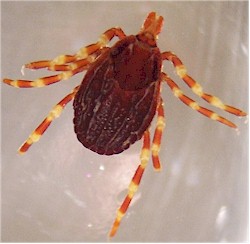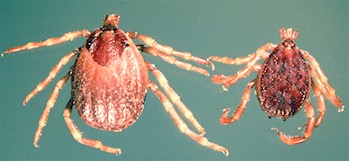Hyalomma is a genus of hard ticks found in vast areas in Mediterranean Europe, Asia, and Africa, with a preference for arid regions. They affect cattle, sheep, goats, horses, camels, dromedaries, dogs, cats, and humans, but also a large range of wild mammals, birds and reptiles. There are about 30 Hyalomma species worldwide, with species-specific distribution and prevalence.
They affect cattle, sheep, goats, horses, camels, dromedaries, dogs, cats, and humans, but also a large range of wild mammals, birds and reptiles. There are about 30 Hyalomma species worldwide, with species-specific distribution and prevalence.
Several species are highly relevant for livestock in the regions where they prevail, comparable with Amblyomma and Rhipicephalus ticks in tropical regions.
The most relevant species for livestock and pests are the following:
- Hyalomma anatolicum, important for livestock; Southern Europe, Near and Middle East, Asia, Northern Africa. Affects cattle, horses, sheep, goats and camels and is one of the most damaging ticks where they prevail.
- Hyalomma dromedarii, Asia, Northern Africa.
- Hyalomma lusitanicum, Southern Europe
- Hyalomma marginatum, Southern Europe, Near and Middle East, Asia.
- Hyalomma truncatum, important for livestock, Northern Africa.
There are specific articles in this site on ticks in dogs and cats, as well as on ticks in horses.
Biology and life cycle of Hyalomma
As all hard ticks, Hyalomma ticks are obligate parasites: they cannot survive without feeding blood of their hosts.
Hyalomma ticks are of a medium to large size, i.e. engorged adult females reach up to 2 cm length. They have quite prominent mouthparts and are of a brownish color.
Most Hyalomma species are three-host ticks, i.e. larvae, nymphs and adults can be found free-living in the environment waiting for a suitable host to pass by. Larvae and nymphs usually infect small mammals (e.g. rodents, rabbits, moles, but also reptiles and birds), whereas adults prefer larger ones, often dogs, but also livestock, wildlife and humans. A particular feature of some Hyalomma ticks is that they can complete development in 1, 2 or 3 different hosts depending on the one they find.
The life cycle can be completed in 3-4 months or longer than one year, depending on the species and on ecological and climatic conditions. Nympgs and adults overwinter in cracks and crevices in the walls of stables or hidden between stones in the unfarmed pastures.
Click here to learn more about the general biology of ticks.
Harm and economic loss due to Hyalomma
As for all ticks, Hyalomma bites cause stress and blood loss to the hosts. A few ticks are usually well tolerated by livestock and pets, but infestations with dozens or hundreds of ticks can significantly weaken affected animals and cause weight loss, reduced fertility, decreased milk production, etc.
Hyalomma ticks are all vectors of several tick-borne diseases of livestock, pets and humans. Hyalomma anatolicum y Hyalomma marginatum transmit various Babesia, Anaplasma, Theileria andTrypanosoma species as well several viruses, e.g. the Crimean–Congo hemorrhagic fever. Hyalomma lusitanicum transmits bovine and ovine babesiosis. Hyalomma truncatum can cause paralysis in livestock, pets and humans.
Non-chemical prevention and control of Hyalomma on livestock

Cebu cattle (Bos indicus) and numerous indigenous breeds are naturally resistant to ticks and tick-borne diseases, whereas European breeds (Bos taurus) are not. An obvious and proven method to reduce cattle tick problems in tick endemic regions is to increase the amount of B. indicus "blood" in the herds. This has been done successfully in a few regions.
Unfortunately, in many other regions the opposite is more frequent. The reason is that producers are often urged to increase the productivity of their properties. Since they can neither reduce their costs, nor increase the cattle density of the farm, a rather cheap and easy option is to introduce more European "blood". It doesn't need significant investments or changes in the infrastructure and management of the property. Social and cultural factors also play a role: European breeds are often perceived as high-tech and prestige livestock.
Pasture burning is a common practice in many regions of the world. Regarding cattle tick control, the experience is that it contributes to reduce the tick numbers to some extent, but it is certainly not enough to eliminate or substantially reduce the tick populations. And it cannot be practiced where livestock shares rangelands with wildlife, as in many regions where these ticks are a problem.
Livestock alternation doesn't help at all with Hyalomma ticks, because they feed on whatever livestock or wildlife. Reducing the number of wild animals can have an impact on Hyalomma populations, but is often impossible or simply unwanted.
Pasture rotation or vacation is not feasible with Hyalomma ticks: they can survive very long without feeding and there will always be enough wild animals around to support tick populations.
Biological control of Hyalomma and other ticks using their natural enemies remains a research topic has not yet delivered really effective and sustainable solutions for tick population control. Tick predators such as insects (e.g. ants, wasps), small rodents or birds (e.g. cattle egrets, guinea fowls, oxpeckers, etc.) do in fact consume significant amounts of ticks, but will not eliminate tick populations. One reason is that they are not specific tick predators, but feed on whatever is available. The most promising results have been obtained so far with so called entomopathogenic fungi, i.e. fungi that are pathogenic for ticks and other insects (e.g. Beauveria bassiana, Metarhizium anisopliae, etc.). In certain countries there are commercial products for crop protection based on such fungi, and there are reports that they can effectively control ticks on cattle too. However, a systematic commercial approach to cattle tick control using such fungi is still missing. In addition, such biological control methods target tick population control and not protection of single animals or killing already attached ticks on an infected animal. For the reasons previously mentioned population control of Hyalomma ticks is virtually impossible in most endemic regions.
Learn more about biological control of ticks and mites.
There are no specific vaccines against Hyalomma ticks. A few reports have shown efficacy of the Boophilus tick vaccine against certain Hyalomma species. However there are so far no are still a research topic and so far there are no such commercial vaccines commercially available.
There are no repellents, chemical or natural, that effectively prevent Hyalomma ticks from attaching to livestock or pets, or that cause already attached ticks to detach.
There are no traps that effectively reduce tick populations in the pastures: whatever domestic or wild animals are much more attractive for ticks than any possible trap.
So far there are no herbal remedies commercially available really effective for protecting livestock from Hyalomma ticks in endemic regions.
Chemical prevention and control of Hyalomma with tickicides
Chemical control and prevention of Hyalomma ticks on livestock is based on the same parasiticides used for the control of other tick species. Most products approved for tick control are based on veteran contact parasiticides of various chemical classes such as:
- Organophosphates (e.g. chlorfenvinphos, chlorpyrifos, coumaphos, diazinon, ethion, etc.)
- Amidines (mainly amitraz, also cymiazole)
- Synthetic pyrethroids (e.g. cypermethrin, deltamethrin, flumethrin, permethrin)
All are for on animal use. In most countries there are currently no tickicides approved for pasture treatment against cattle ticks. The major reason is that to effectively control the ticks on pasture the dose will be lethal for almost any invertebrate fauna in the pastures and for most of the vertebrates that feed on them (birds, reptiles, rodents, etc.). In addition, pastures would be also contaminated with chemicals, which could be toxic for livestock or leave illegal residues in meat and/or milk.
Organochlorines were vastly used in the past, but are now prohibited for livestock in most countries. Neonicotinoids are not effective against ticks. Carbamates are often not effective enough against ticks.
These veteran acaricides are mostly available as concentrates for topical administration as dips and sprays, or as ready-to-use pour-ons. As a thumb rule, dips are more effective than sprays and pour-ons, simply because sprays and pour-ons do not ensure a complete coverage of the whole body (e.g. ears, udders, perineum, below the tail etc.).
Insecticide-impregnated ear-tags, dusts and back rubbers are not suited for the control of most Hyalomma ticks.
Neither macrocyclic lactones (e.g. doramectin, eprinomectin, ivermectin, moxidectin), nor tick development inhibitors (fluazuron) ensure adequate control of Hyalomma ticks on livestock (or any other multi-host tick species). This means that there are no systemic tickicides suited for controlling Hyalomma ticks, and consequently neither injectables, nor drenches nor feed additives.
Click here to learn more about general features of parasiticides.
Click here to learn more about delivery forms of parasiticides.
| If available, follow more specific national or regional recommendations or regulations for tick control. |
Resistance of Hyalomma ticks to tickicides
There are a few reports on low level resistance of Hyalomma ticks to synthetic pyrethroids and organophosphates in India. However, if a tickicide fails to achieve the expected efficacy, chance is rather high that either the product was unsuited for Hyalomma control, or it was used incorrectly.
Learn more about parasite resistance and how it develops.